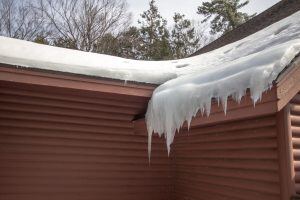When winter hits Minnesota hard, homeowners face one of the most frustrating and expensive roofing issues: ice dams. These thick ridges of ice that form along the edge of your roof may look harmless at first, but they can quickly cause leaks, water damage, and even structural problems if left unchecked. Understanding what causes ice dams—and how to prevent them—can save you thousands in repairs and protect your home all season long.
What Exactly Is an Ice Dam?
An ice dam happens when heat escapes from your attic and melts the snow on your roof. As that water runs down and reaches the colder edges, it refreezes. Over time, this freeze–thaw cycle creates a solid wall of ice.
Once that ice forms, melted snow behind it has nowhere to go, so it backs up under your shingles, into your attic, and even into your walls.
Common Signs You May Have an Ice Dam
- Icicles hanging from gutters or roof edges
- Water stains on ceilings or interior walls
- Ice buildup on soffits or around vents
- Uneven patches of melted snow on your roof
If you see these, it's time to act fast.
Why Ice Dams Cause Big (and Expensive) Problems
Ice dams can lead to:
- Shingle damage
- Rotting roof decking
- Wet insulation
- Mold growth
- Interior ceiling and wall damage
What starts as a little ice can quickly turn into a major repair bill.
How to Prevent Ice Dams Before They Form
1. Improve Your Attic Insulation
Proper insulation keeps warm air inside your home instead of escaping into your attic. This reduces uneven roof temperatures and stops that melt-and-refreeze cycle that causes dams.
2. Seal Air Leaks
Small gaps around light fixtures, plumbing, vents, or chimneys allow warm air to escape upward. Air sealing keeps the attic cold and your roof temperature consistent.
3. Increase Attic Ventilation
A well-balanced ventilation system keeps your attic cool and dry by allowing cold air to enter and warm air to escape. This is crucial for minimizing ice dam risks.
4. Keep Gutters Clear
Clogged gutters trap water and make it easier for ice to build up. A quick cleanout before a storm can make a big difference.
5. Use Roof Rakes After Heavy Snowfall
Removing the first few feet of snow from the roof edge helps prevent ice buildup, especially during back-to-back storms.
6. Schedule a Professional Roof & Attic Inspection
A trained roofing expert can spot insulation gaps, ventilation issues, or potential weak spots long before winter hits. Preventative care is always cheaper than emergency repairs.
When to Call a Professional
If you notice water stains, sagging ceilings, or large icicles forming, don’t wait. Ice dam damage can spread quickly, and DIY removal can be dangerous. Professional teams—like Precise Exteriors can safely remove ice dams and assess any hidden damage.
Final Thoughts
Ice dams are common in our Minnesota winters, but they don’t have to be a yearly headache. With proper insulation, ventilation, and preventative care, you can keep your home safe, dry, and protected no matter how harsh the season gets.
Precise Exteriors is here to help you prepare and stay ahead of winter’s costliest roofing problems.

.png?width=900&name=Precise%20(10).png)
.png?width=900&name=Precise%20(8).png)
